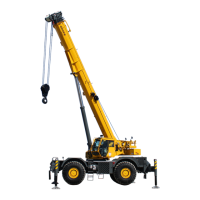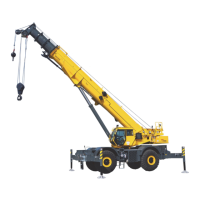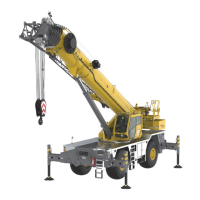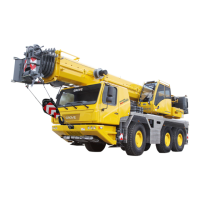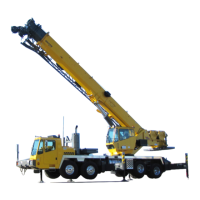Do you have a question about the Manitowoc Grove GRT655 and is the answer not in the manual?
Provides an overview of the crane's rough terrain features, drive train, and superstructure.
Information on contacting Grove and distributors for assistance, parts, service, and warranty.
Instructions for new owners to register their Grove crane for contact purposes.
Details on guaranteed sound power levels and vibration exposure at the operator station.
Identifies the locations where serial numbers are stamped or found on the crane.
Comprehensive list of crane specifications including dimensions, capacities, engine, and transmission details.
Explains the importance of safety messages, symbols, and signal words used throughout the manual.
Emphasizes the need to read and understand the operator manual and load chart before operation.
Defines a qualified person and highlights essential training and familiarity requirements.
Details accessories that provide information or control functions to facilitate safe crane operation.
Explains the RCL system's function in monitoring load and preventing overloads.
Describes the anti-two-block system and its importance in preventing boom tip contact.
Highlights critical factors for crane stability, including firm surfaces and proper outrigger setup.
Explains the importance of load charts for determining lifting capacities and understanding configurations.
Emphasizes the need to inspect the entire work site for conditions affecting crane stability.
Provides principles for operating in windy conditions and the effect of wind on crane loads.
Outlines procedures and precautions for safe lifting operations, including load handling and placement.
Details hazards associated with operating near electrical power lines and sources.
Covers requirements and precautions for using cranes to lift personnel.
Provides guidelines for the proper disposal of potentially harmful waste materials.
Stresses the importance of regular inspection, maintenance, and operation of a well-maintained crane.
Specifies that service and repairs must only be performed by qualified personnel.
Details the importance of proper lubrication and the precautions to take when servicing the hydraulic system.
Covers inspection of tires for damage, wear, and correct inflation pressures.
Provides guidelines for the inspection and use of hoist ropes, including wire rope and synthetic rope.
Outlines precautions for checking and maintaining batteries, including safety measures.
Details precautions for checking and maintaining the super capacitor, especially in cold weather.
Provides general guidelines for fueling, engine checks, and performing maintenance safely.
Covers checks for route suitability, load limits, securing the crane for transport, and boom positioning.
Provides guidelines for safe travel, including boom retraction, turntable lock, and speed adherence.
Covers personal considerations, crane access, and job preparation for safe crane operation.
Provides guidance on the safe operation of the crane on slopes, including general conditions and limitations.
Details procedures and hazards related to the erection, stowage, and use of the boom extension.
Outlines instructions for parking the crane safely, especially when unattended.
Provides step-by-step instructions for properly shutting down the crane.
Offers recommendations for operating cranes in cold regions and lists necessary cold weather accessories.
Explains how temperature affects hook block working load limits and lifting precautions.
Details how temperature changes affect hydraulic oil viscosity and cylinder operation.
Provides information specific to crane models regarding stability and hoist platform usage.
Outlines procedures for inspecting the crane after an overload condition is detected by the RCL system.
Provides a checklist for inspecting the boom, including wear pads, cylinders, and welds.
Details inspection points for the superstructure, including lift cylinders, turntable, and welds.
Provides a checklist for inspecting the carrier, including jack cylinders, outrigger pads, and beams.
Overview of controls and indicators found inside the crane cab for operating and monitoring functions.
Description of the tilt and telescoping steering column assembly and its integrated controls.
Details on controls located in the cab overhead console, including skylight and fan operations.
Information on switches for skylight wiper, HVAC, work lights, and exhaust system cleaning.
Description of the ODM and RDM modules, their screens, navigation pads, and warning indicators.
Explains how to navigate through function screens using the control pads on the ODM and RDM.
Details the function of the USB connector for software updates and data logging.
Explains the red indicator that signals a lift exceeding capacity, leading to function lockouts.
Describes the amber indicator signaling a lift between 90% and 100% of rated capacity.
Details the red indicator that activates when the anti-two-block system is triggered, locking hoist functions.
Explains the amber indicator that signals when the swing brake is applied.
Describes the sensor that automatically adjusts screen brightness based on cab ambient light.
Details indicators for module internal temperatures being too high or too low.
Overview of controls and features integrated into the operator's seat assembly.
Describes the function of various foot pedals used for crane operations like swing lock and telescope.
Covers various controls and indicators, including fuse panels, buzzers, and bypass switches.
Explains the use of the limit bypass switch to override RCL system functions during rigging or recovery.
Details the bridging switch for bypassing limiter systems and its associated indicators.
Describes the internal light bar as an operational aid for overload condition warnings.
Explains the external light tower's function in warning operators of approaching overload conditions.
Details the operation of the strobe light or beacon, which is on when the ignition switch is on.
Describes the audio system used to warn personnel when the crane is backing up.
Identifies the windshield as the emergency exit, to be used if the door is blocked.
Explains the control handle for locking the turntable swing pin to secure the superstructure.
Describes the engine block heater for cold weather operation and its power connection.
Details the Birdseye Camera system, its views, and how to adjust display settings.
Covers essential walk-around checks for safe operation, including fuel, oil, coolant, and batteries.
Provides procedures for starting, idling, and operating the engine, including cold weather considerations.
Warns against jump-starting the crane due to potential damage to electronic systems.
Details procedures for charging batteries, including safety precautions and slow charging preference.
Step-by-step guide for starting the engine, including pre-start inspections and checks.
Explains the negative effects of unnecessary engine idling and recommends maintaining a minimum RPM.
Describes the automatic increase in engine idle speed to minimize degradation and damage.
Covers procedures for manual and active exhaust system cleaning to maintain DPF performance.
Provides recommendations for operating in cold regions and lists necessary cold weather accessories.
Details procedures for warming up various crane components before operation, especially in cold weather.
Covers general procedures and safety warnings for driving the crane.
Emphasizes operator responsibility for travel suitability, especially on slopes and roadways.
Details conditions and precautions for operating the crane on uneven surfaces and slopes.
Specifies limits for fore/aft travel based on slope percentage and drive conditions.
Defines the maximum allowable side slope for safe crane operation.
Provides precautions for driving the crane with an elevated boom, emphasizing clearance and control.
Outlines specific procedures and limitations when traveling with a boom extension erected.
Addresses tire inflation pressures and cooling requirements for extended site-to-site travel.
Step-by-step instructions for moving the crane forward, including gear selection and pedal operation.
Similar to forward travel, details the procedure for moving the crane in reverse.
Explains the steering capabilities including front, rear, four-wheel, and crab steering.
Provides instructions for engaging four-wheel drive to increase traction when wheels are slipping.
Details the purpose and operation of the differential lock for maximum traction on poor surfaces.
Explains the operation of the high-speed glide system for smoother travel at higher speeds.
Describes the proportional controller operation and proper crane leveling procedures.
Emphasizes the importance of a level crane for allowable capacities and outlines leveling procedures.
Details how to extend and retract outriggers using the ODM and the importance of proper setup.
Step-by-step guide for extending and setting outriggers and jacks to achieve a level crane.
Provides instructions on how to engage the lock pin for outrigger beams at the mid-extend position.
Details the procedure for retracting outrigger jacks and beams, and stowing pads.
Covers safe practices for swinging the boom and superstructure, including swing brake engagement.
Explains the procedures for raising and lowering the boom, including safety precautions.
Describes how to extend and retract the boom sections using controllers or foot pedals.
Provides instructions for operating the main hoist to lower or raise the rope, including brake engagement.
Details procedures for operating the auxiliary hoist to lower or raise the rope.
Explains how to enable main and auxiliary hoist functions at high speed.
Covers procedures for properly stowing and parking the crane, including safety precautions.
Outlines factors to consider when leaving the crane unattended, emphasizing safety and configuration.
Guides the operator through navigating the ODM and RDM screens using control pads and the jog dial.
Explains how to use the main and menu screens of the ODM for monitoring and control.
Describes the icons appearing in the Status Area of the ODM Main Screen for system monitoring.
Details the icons appearing in the Alerts Area of the ODM Main Screen for warnings and faults.
Guides the operator on programming the RCL using manual code entry or the setup wizard.
Step-by-step instructions for manually entering a load chart code number into the RCL Setup Screen.
Explains how to use the RCL Setup Wizard to define crane configurations for different tire or outrigger setups.
Details how to override the OMS detected outrigger beam configuration when it doesn't match programmed settings.
Describes how to show and use the tare function on the RDM for weighing operations.
Confirms when limiters are bypassed via the Limit Bypass Switch, using RDM indicators.
Lists and defines indicators appearing on the RDM Main Screen for load chart and system status.
Explains how to toggle the optional rear view camera on and off using the RDM screen.
Details the Birdseye Camera system, its views, and how to adjust display settings.
Instructions for placing components in transport and working positions before and after transportation.
Safety warnings and procedures for using the hoist platform.
Step-by-step procedure for installing the hoist rope onto the hoist drum.
Details on locking and unlocking the A2B switch for proper system function.
Covers checks for electrical connections, A2B switches, RCL cable drums, and warning indicators.
Explains how to reeve hoist rope, including multi-part lines and using a qualified rigger.
Details on the popular wedge socket assembly for terminating wire ropes and proper installation.
Step-by-step instructions for inspecting and installing wire rope into a wedge socket assembly.
Covers procedures for erecting and stowing the boom extension, including safety warnings.
Provides detailed steps for erecting the boom extension, including tools and safety precautions.
Details the procedure for stowing the boom extension, including retracting boom and disconnecting cables.
Explains how to set the boom extension offset from lesser to higher degrees and vice versa.
Covers procedures for extending and stowing the telescoping boom extension fly section.
Emphasizes the importance of lubrication procedures for crane lifetime and utilization.
Provides guidelines for the proper handling and disposal of potentially harmful waste materials.
Details lubricant types, intervals, and recommendations for normal and extreme conditions.
Lists recommended standard lubricants effective in temperatures down to -9°C (15°F).
Provides recommendations for arctic lubricants and conditions for temperatures below -9°C (15°F).
Discusses steel cylinder rod protection and recommends using Boeshield® T-9 for exposed rods.
Explains the need for periodic lubrication of wire rope to maintain its life and performance.
Details the frequency and methods for lubricating various points on the crane.
Grove Crane's recommendation for using CraneLUBE lubricants for enhanced reliability and performance.
Information on accessing Cummins' program for engine oils tested to meet engineering specifications.
General safety precautions for lubricating the crane, especially around the engine and moving parts.
Covers lubrication points and intervals for the drive train components, including filters and seals.
Details lubrication points and intervals for steering and suspension components like pivot pins and fifth wheel.
Provides information on checking and draining lubricants for differentials and planetary hubs.
Covers lubrication procedures for the turntable gearbox, gear and drive pinion, and bearing.
Details lubrication for tilt cylinder pivot pins and pillow blocks.
Specifies lubrication for wear pads, outrigger beams, and jack cylinder support tubes.
Covers lubrication for boom components, including pivot shafts, sheaves, and wear pads.
Provides lubrication procedures for the main and auxiliary hoists, including rope follower and lower limit switch.
Details inspection and maintenance of the hydraulic oil, filters, and tank breathers.
Explains Grove's rust inhibitor treatment and provides guidelines for maintaining paint finish.
Offers guidelines for washing the crane, including using high pressure water and recommended soaps.
Covers procedures for inspecting for damage, repairing scratches, and recommendations for paint touch-ups.
Discusses where rust inhibitor treatment is applied based on environmental conditions.
Lists specific areas on the unit, frame, and superstructure where rust inhibitor is applied.
Provides an overview of the crane's rough terrain features, drive train, and superstructure.
Information on contacting Grove and distributors for assistance, parts, service, and warranty.
Instructions for new owners to register their Grove crane for contact purposes.
Details on guaranteed sound power levels and vibration exposure at the operator station.
Identifies the locations where serial numbers are stamped or found on the crane.
Comprehensive list of crane specifications including dimensions, capacities, engine, and transmission details.
Explains the importance of safety messages, symbols, and signal words used throughout the manual.
Emphasizes the need to read and understand the operator manual and load chart before operation.
Defines a qualified person and highlights essential training and familiarity requirements.
Details accessories that provide information or control functions to facilitate safe crane operation.
Explains the RCL system's function in monitoring load and preventing overloads.
Describes the anti-two-block system and its importance in preventing boom tip contact.
Highlights critical factors for crane stability, including firm surfaces and proper outrigger setup.
Explains the importance of load charts for determining lifting capacities and understanding configurations.
Emphasizes the need to inspect the entire work site for conditions affecting crane stability.
Provides principles for operating in windy conditions and the effect of wind on crane loads.
Outlines procedures and precautions for safe lifting operations, including load handling and placement.
Details hazards associated with operating near electrical power lines and sources.
Covers requirements and precautions for using cranes to lift personnel.
Provides guidelines for the proper disposal of potentially harmful waste materials.
Stresses the importance of regular inspection, maintenance, and operation of a well-maintained crane.
Specifies that service and repairs must only be performed by qualified personnel.
Details the importance of proper lubrication and the precautions to take when servicing the hydraulic system.
Covers inspection of tires for damage, wear, and correct inflation pressures.
Provides guidelines for the inspection and use of hoist ropes, including wire rope and synthetic rope.
Outlines precautions for checking and maintaining batteries, including safety measures.
Details precautions for checking and maintaining the super capacitor, especially in cold weather.
Provides general guidelines for fueling, engine checks, and performing maintenance safely.
Covers checks for route suitability, load limits, securing the crane for transport, and boom positioning.
Provides guidelines for safe travel, including boom retraction, turntable lock, and speed adherence.
Covers personal considerations, crane access, and job preparation for safe crane operation.
Provides guidance on the safe operation of the crane on slopes, including general conditions and limitations.
Details procedures and hazards related to the erection, stowage, and use of the boom extension.
Outlines instructions for parking the crane safely, especially when unattended.
Provides step-by-step instructions for properly shutting down the crane.
Offers recommendations for operating cranes in cold regions and lists necessary cold weather accessories.
Explains how temperature affects hook block working load limits and lifting precautions.
Details how temperature changes affect hydraulic oil viscosity and cylinder operation.
Provides information specific to crane models regarding stability and hoist platform usage.
Outlines procedures for inspecting the crane after an overload condition is detected by the RCL system.
Provides a checklist for inspecting the boom, including wear pads, cylinders, and welds.
Details inspection points for the superstructure, including lift cylinders, turntable, and welds.
Provides a checklist for inspecting the carrier, including jack cylinders, outrigger pads, and beams.
Overview of controls and indicators found inside the crane cab for operating and monitoring functions.
Description of the tilt and telescoping steering column assembly and its integrated controls.
Details on controls located in the cab overhead console, including skylight and fan operations.
Information on switches for skylight wiper, HVAC, work lights, and exhaust system cleaning.
Description of the ODM and RDM modules, their screens, navigation pads, and warning indicators.
Explains how to navigate through function screens using the control pads on the ODM and RDM.
Details the function of the USB connector for software updates and data logging.
Explains the red indicator that signals a lift exceeding capacity, leading to function lockouts.
Describes the amber indicator signaling a lift between 90% and 100% of rated capacity.
Details the red indicator that activates when the anti-two-block system is triggered, locking hoist functions.
Explains the amber indicator that signals when the swing brake is applied.
Describes the sensor that automatically adjusts screen brightness based on cab ambient light.
Details indicators for module internal temperatures being too high or too low.
Overview of controls and features integrated into the operator's seat assembly.
Describes the function of various foot pedals used for crane operations like swing lock and telescope.
Covers various controls and indicators, including fuse panels, buzzers, and bypass switches.
Explains the use of the limit bypass switch to override RCL system functions during rigging or recovery.
Details the bridging switch for bypassing limiter systems and its associated indicators.
Describes the internal light bar as an operational aid for overload condition warnings.
Explains the external light tower's function in warning operators of approaching overload conditions.
Details the operation of the strobe light or beacon, which is on when the ignition switch is on.
Describes the audio system used to warn personnel when the crane is backing up.
Identifies the windshield as the emergency exit, to be used if the door is blocked.
Explains the control handle for locking the turntable swing pin to secure the superstructure.
Describes the engine block heater for cold weather operation and its power connection.
Details the Birdseye Camera system, its views, and how to adjust display settings.
Covers essential walk-around checks for safe operation, including fuel, oil, coolant, and batteries.
Provides procedures for starting, idling, and operating the engine, including cold weather considerations.
Warns against jump-starting the crane due to potential damage to electronic systems.
Details procedures for charging batteries, including safety precautions and slow charging preference.
Step-by-step guide for starting the engine, including pre-start inspections and checks.
Explains the negative effects of unnecessary engine idling and recommends maintaining a minimum RPM.
Describes the automatic increase in engine idle speed to minimize degradation and damage.
Covers procedures for manual and active exhaust system cleaning to maintain DPF performance.
Provides recommendations for operating in cold regions and lists necessary cold weather accessories.
Details procedures for warming up various crane components before operation, especially in cold weather.
Covers general procedures and safety warnings for driving the crane.
Emphasizes operator responsibility for travel suitability, especially on slopes and roadways.
Details conditions and precautions for operating the crane on uneven surfaces and slopes.
Specifies limits for fore/aft travel based on slope percentage and drive conditions.
Defines the maximum allowable side slope for safe crane operation.
Provides precautions for driving the crane with an elevated boom, emphasizing clearance and control.
Outlines specific procedures and limitations when traveling with a boom extension erected.
Addresses tire inflation pressures and cooling requirements for extended site-to-site travel.
Step-by-step instructions for moving the crane forward, including gear selection and pedal operation.
Similar to forward travel, details the procedure for moving the crane in reverse.
Explains the steering capabilities including front, rear, four-wheel, and crab steering.
Provides instructions for engaging four-wheel drive to increase traction when wheels are slipping.
Details the purpose and operation of the differential lock for maximum traction on poor surfaces.
Explains the operation of the high-speed glide system for smoother travel at higher speeds.
Describes the proportional controller operation and proper crane leveling procedures.
Emphasizes the importance of a level crane for allowable capacities and outlines leveling procedures.
Details how to extend and retract outriggers using the ODM and the importance of proper setup.
Step-by-step guide for extending and setting outriggers and jacks to achieve a level crane.
Provides instructions on how to engage the lock pin for outrigger beams at the mid-extend position.
Details the procedure for retracting outrigger jacks and beams, and stowing pads.
Covers safe practices for swinging the boom and superstructure, including swing brake engagement.
Explains the procedures for raising and lowering the boom, including safety precautions.
Describes how to extend and retract the boom sections using controllers or foot pedals.
Provides instructions for operating the main hoist to lower or raise the rope, including brake engagement.
Details procedures for operating the auxiliary hoist to lower or raise the rope.
Explains how to enable main and auxiliary hoist functions at high speed.
Covers procedures for properly stowing and parking the crane, including safety precautions.
Outlines factors to consider when leaving the crane unattended, emphasizing safety and configuration.
Guides the operator through navigating the ODM and RDM screens using control pads and the jog dial.
Explains how to use the main and menu screens of the ODM for monitoring and control.
Describes the icons appearing in the Status Area of the ODM Main Screen for system monitoring.
Details the icons appearing in the Alerts Area of the ODM Main Screen for warnings and faults.
Guides the operator on programming the RCL using manual code entry or the setup wizard.
Step-by-step instructions for manually entering a load chart code number into the RCL Setup Screen.
Explains how to use the RCL Setup Wizard to define crane configurations for different tire or outrigger setups.
Details how to override the OMS detected outrigger beam configuration when it doesn't match programmed settings.
Describes how to show and use the tare function on the RDM for weighing operations.
Confirms when limiters are bypassed via the Limit Bypass Switch, using RDM indicators.
Lists and defines indicators appearing on the RDM Main Screen for load chart and system status.
Explains how to toggle the optional rear view camera on and off using the RDM screen.
Details the Birdseye Camera system, its views, and how to adjust display settings.
Instructions for placing components in transport and working positions before and after transportation.
Safety warnings and procedures for using the hoist platform.
Step-by-step procedure for installing the hoist rope onto the hoist drum.
Details on locking and unlocking the A2B switch for proper system function.
Covers checks for electrical connections, A2B switches, RCL cable drums, and warning indicators.
Explains how to reeve hoist rope, including multi-part lines and using a qualified rigger.
Details on the popular wedge socket assembly for terminating wire ropes and proper installation.
Step-by-step instructions for inspecting and installing wire rope into a wedge socket assembly.
Covers procedures for erecting and stowing the boom extension, including safety warnings.
Provides detailed steps for erecting the boom extension, including tools and safety precautions.
Details the procedure for stowing the boom extension, including retracting boom and disconnecting cables.
Explains how to set the boom extension offset from lesser to higher degrees and vice versa.
Covers procedures for extending and stowing the telescoping boom extension fly section.
Emphasizes the importance of lubrication procedures for crane lifetime and utilization.
Provides guidelines for the proper handling and disposal of potentially harmful waste materials.
Details lubricant types, intervals, and recommendations for normal and extreme conditions.
Lists recommended standard lubricants effective in temperatures down to -9°C (15°F).
Provides recommendations for arctic lubricants and conditions for temperatures below -9°C (15°F).
Discusses steel cylinder rod protection and recommends using Boeshield® T-9 for exposed rods.
Explains the need for periodic lubrication of wire rope to maintain its life and performance.
Details the frequency and methods for lubricating various points on the crane.
Grove Crane's recommendation for using CraneLUBE lubricants for enhanced reliability and performance.
Information on accessing Cummins' program for engine oils tested to meet engineering specifications.
General safety precautions for lubricating the crane, especially around the engine and moving parts.
Covers lubrication points and intervals for the drive train components, including filters and seals.
Details lubrication points and intervals for steering and suspension components like pivot pins and fifth wheel.
Provides information on checking and draining lubricants for differentials and planetary hubs.
Covers lubrication procedures for the turntable gearbox, gear and drive pinion, and bearing.
Details lubrication for tilt cylinder pivot pins and pillow blocks.
Specifies lubrication for wear pads, outrigger beams, and jack cylinder support tubes.
Covers lubrication for boom components, including pivot shafts, sheaves, and wear pads.
Provides lubrication procedures for the main and auxiliary hoists, including rope follower and lower limit switch.
Details inspection and maintenance of the hydraulic oil, filters, and tank breathers.
Explains Grove's rust inhibitor treatment and provides guidelines for maintaining paint finish.
Offers guidelines for washing the crane, including using high pressure water and recommended soaps.
Covers procedures for inspecting for damage, repairing scratches, and recommendations for paint touch-ups.
Discusses where rust inhibitor treatment is applied based on environmental conditions.
Lists specific areas on the unit, frame, and superstructure where rust inhibitor is applied.
| Brand | Manitowoc |
|---|---|
| Model | Grove GRT655 |
| Category | Construction Equipment |
| Language | English |

